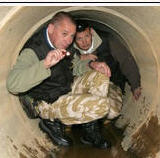Madeleine McCann and the Microchipping Agenda
Page 1 of 1 • Share
 Madeleine McCann and the Microchipping Agenda
Madeleine McCann and the Microchipping Agenda
[You must be registered and logged in to see this link.]
Article posted by Tony Bennett on the 3 arguidos 27.5.09
Article from the [You must be registered and logged in to see this link.], 2006, looking into the future of microchipping. See the paragraph I've highlighted in red.
One generation is all they need
Spencer Wynn/Toronto Star
One day we will all happily be implanted with microchips, and our every move will be monitored. The technology exists; the only barrier is society's resistance to the loss of privacy. An expert on surveillance and society lays out how corporations and governments are progressing towards microchipping everybody
Dec 10, 2006 04:30 AM
By the time my four-year-old son is swathed in the soft flesh of old age, he will likely find it unremarkable that he and almost everyone he knows will be permanently implanted with a microchip. Automatically tracking his location in real time, it will connect him with databases monitoring and recording his smallest behavioural traits.
Most people anticipate such a prospect with a sense of horrified disbelief, dismissing it as a science-fiction fantasy. The technology, however, already exists. For years humane societies have implanted all the pets that leave their premises with a small identifying microchip. As well, millions of consumer goods are now traced with tiny radio frequency identification chips that allow satellites to reveal their exact location.
A select group of people are already "chipped" with devices that automatically open doors, turn on lights, and perform other low-level miracles. Prominent among such individuals is researcher Kevin Warwick of Reading University in England; Warwick is a leading proponent of the almost limitless potential uses for such chips.
Other users include the patrons of the Baja Beach Club in Barcelona, many of whom have paid about $150 (U.S.) for the privilege of being implanted with an identifying chip that allows them to bypass lengthy club queues and purchase drinks by being scanned. These individuals are the advance guard of an effort to expand the technology as widely as possible.
From this point forward, microchips will become progressively smaller, less invasive, and easier to deploy. Thus, any realistic barrier to the wholesale "chipping" of Western citizens is not technological but cultural. It relies upon the visceral reaction against the prospect of being personally marked as one component in a massive human inventory.
Today we might strongly hold such beliefs, but sensibilities can, and probably will, change. How this remarkable attitudinal transformation is likely to occur is clear to anyone who has paid attention to privacy issues over the past quarter-century. There will be no 3 a.m. knock on the door by storm troopers come to force implants into our bodies. The process will be more subtle and cumulative, couched in the unassailable language of progress and social betterment, and mimicking many of the processes that have contributed to the expansion of closed-circuit television cameras and the corporate market in personal data.
A series of tried and tested strategies will be marshalled to familiarize citizens with the technology. These will be coupled with efforts to pressure tainted social groups and entice the remainder of the population into being chipped.
This, then, is how the next generation will come to be microchipped.
It starts in distant countries. Having tested the technology on guinea pigs, both human and animal, the first widespread use of human implanting will occur in nations at the periphery of the Western world. Such developments are important in their own right, but their international significance pertains to how they familiarize a global audience with the technology and habituate them to the idea that chipping represents a potential future.
An increasing array of hypothetical chipping scenarios will also be depicted in entertainment media, furthering the familiarization process.
In the West, chips will first be implanted in members of stigmatized groups. Pedophiles are the leading candidate for this distinction, although it could start with terrorists, drug dealers, or whatever happens to be that year's most vilified criminals. Short-lived promises will be made that the technology will only be used on the "worst of the worst." In fact, the wholesale chipping of incarcerated individuals will quickly ensue, encompassing people on probation and on parole.
Even accused individuals will be tagged, a measure justified on the grounds that it would stop them from fleeing justice. Many prisoners will welcome this development, since only chipped inmates will be eligible for parole, weekend release, or community sentences. From the prison system will emerge an evocative vocabulary distinguishing chippers from non-chippers.
Although the chips will be justified as a way to reduce fraud and other crimes, criminals will almost immediately develop techniques to simulate other people's chip codes and manipulate their data.
The comparatively small size of the incarcerated population, however, means that prisons would be simply a brief stopover on a longer voyage. Commercial success is contingent on making serious inroads into tagging the larger population of law-abiding citizens. Other stigmatized groups will therefore be targeted. This will undoubtedly entail monitoring welfare recipients, a move justified to reduce fraud, enhance efficiency, and ensure that the poor do not receive "undeserved" benefits.
Once e-commerce is sufficiently advanced, welfare recipients will receive their benefits as electronic vouchers stored on their microchips, a policy that will be tinged with a sense of righteousness, as it will help ensure that clients can only purchase government-approved goods from select merchants, reducing the always disconcerting prospect that poor people might use their limited funds to purchase alcohol or tobacco.
Civil libertarians will try to foster a debate on these developments. Their attempts to prohibit chipping will be handicapped by the inherent difficulty in animating public sympathy for criminals and welfare recipients — groups that many citizens are only too happy to see subjected to tighter regulation. Indeed, the lesser public concern for such groups is an inherent part of the unarticulated rationale for why coerced chipping will be disproportionately directed at the stigmatized.
The official privacy arm of the government will now take up the issue. Mandated to determine the legality of such initiatives, privacy commissioners and Senate Committees will produce a forest of reports presented at an archipelago of international conferences. Hampered by lengthy research and publication timelines, their findings will be delivered long after the widespread adoption of chipping is effectively a fait accompli. The research conclusions on the effectiveness of such technologies will be mixed and open to interpretation.
Officials will vociferously reassure the chipping industry that they do not oppose chipping itself, which has fast become a growing commercial sector. Instead, they are simply seeking to ensure that the technology is used fairly and that data on the chips is not misused. New policies will be drafted.
Employers will start to expect implants as a condition of getting a job. The U.S. military will lead the way, requiring chips for all soldiers as a means to enhance battlefield command and control — and to identify human remains. From cooks to commandos, every one of the more than one million U.S. military personnel will see microchips replace their dog tags.
Following quickly behind will be the massive security sector. Security guards, police officers, and correctional workers will all be expected to have a chip. Individuals with sensitive jobs will find themselves in the same position.
The first signs of this stage are already apparent. In 2004, the Mexican attorney general's office started implanting employees to restrict access to secure areas. The category of "sensitive occupation" will be expansive to the point that anyone with a job that requires keys, a password, security clearance, or identification badge will have those replaced by a chip.
Judges hearing cases on the constitutionality of these measures will conclude that chipping policies are within legal limits. The thin veneer of "voluntariness" coating many of these programs will allow the judiciary to maintain that individuals are not being coerced into using the technology.
In situations where the chips are clearly forced on people, the judgments will deem them to be undeniable infringements of the right to privacy. However, they will then invoke the nebulous and historically shifting standard of "reasonableness" to pronounce coerced chipping a reasonable infringement on privacy rights in a context of demands for governmental efficiency and the pressing need to enhance security in light of the still ongoing wars on terror, drugs, and crime.
At this juncture, an unfortunately common tragedy of modern life will occur: A small child, likely a photogenic toddler, will be murdered or horrifically abused. It will happen in one of the media capitals of the Western world, thereby ensuring non-stop breathless coverage. Chip manufactures will recognize this as the opportunity they have been anticipating for years. With their technology now largely bug-free, familiar to most citizens and comparatively inexpensive, manufacturers will partner with the police to launch a high-profile campaign encouraging parents to implant their children "to ensure your own peace of mind."
Special deals will be offered. Implants will be free, providing the family registers for monitoring services. Loving but unnerved parents will be reassured by the ability to integrate tagging with other functions on their PDA so they can see their child any time from any place.
Paralleling these developments will be initiatives that employ the logic of convenience to entice the increasingly small group of holdouts to embrace the now common practice of being tagged. At first, such convenience tagging will be reserved for the highest echelon of Western society, allowing the elite to move unencumbered through the physical and informational corridors of power. Such practices will spread more widely as the benefits of being chipped become more prosaic. Chipped individuals will, for example, move more rapidly through customs.
Indeed, it will ultimately become a condition of using mass-transit systems that officials be allowed to monitor your chip. Companies will offer discounts to individuals who pay by using funds stored on their embedded chip, on the small-print condition that the merchant can access large swaths of their personal data. These "discounts" are effectively punitive pricing schemes, charging unchipped individuals more as a way to encourage them to submit to monitoring. Corporations will seek out the personal data in hopes of producing ever more fine-grained customer profiles for marketing purposes, and to sell to other institutions.
By this point all major organizations will be looking for opportunities to capitalize on the possibilities inherent in an almost universally chipped population. The uses of chips proliferate, as do the types of discounts. Each new generation of household technology becomes configured to operate by interacting with a person's chip.
Finding a computer or appliance that will run though old-fashioned "hands-on"' interactions becomes progressively more difficult and costly. Patients in hospitals and community care will be routinely chipped, allowing medical staff — or, more accurately, remote computers — to monitor their biological systems in real time.
Eager to reduce the health costs associated with a largely docile citizenry, authorities will provide tax incentives to individuals who exercise regularly. Personal chips will be remotely monitored to ensure that their heart rate is consistent with an exercise regime.
By now, the actual process of "chipping" for many individuals will simply involve activating certain functions of their existing chip. Any prospect of removing the chip will become increasingly untenable, as having a chip will be a precondition for engaging in the main dynamics of modern life, such as shopping, voting, and driving.
The remaining holdouts will grow increasingly weary of Luddite jokes and subtle accusations that they have something to hide. Exasperated at repeatedly watching neighbours bypass them in "chipped" lines while they remain subject to the delays, inconveniences, and costs reserved for the unchipped, they too will choose the path of least resistance and get an implant.
In one generation, then, the cultural distaste many might see as an innate reaction to the prospect of having our bodies marked like those of an inmate in a concentration camp will likely fade.
In the coming years some of the most powerful institutional actors in society will start to align themselves to entice, coerce, and occasionally compel the next generation to get an implant.
Now, therefore, is the time to contemplate the unprecedented dangers of this scenario. The most serious of these concern how even comparatively stable modern societies will, in times of fear, embrace treacherous promises. How would the prejudices of a Joe McCarthy, J. Edgar Hoover, or of southern Klansmen — all of whom were deeply integrated into the American political establishment — have manifest themselves in such a world? What might Hitler, Mao or Milosevic have accomplished if their citizens were chipped, coded, and remotely monitored?
Choirs of testimonials will soon start to sing the virtues of implants. Calm reassurances will be forthcoming about democratic traditions, the rule of law, and privacy rights. History, unfortunately, shows that things can go disastrously wrong, and that this happens with disconcerting regularity. Little in the way of international agreements, legality, or democratic sensibilities has proved capable of thwarting single-minded ruthlessness.
"It can't happen here" has become the whispered swan song of the disappeared. Best to contemplate these dystopian potentials before we proffer the tender forearms of our sons and daughters. While we cannot anticipate all of the positive advantages that might be derived from this technology, the negative prospects are almost too terrifying to contemplate.
-----
If your child could wear an implant – a microchip that could tell a computer where he or she was at any time to within a few metres – would you buy it? After the horrific snatch of three-year-old Madeleine McCann from her bed in Portugal, the answer from many parents seems to be “yes”. Professor Kevin Warwick, who developed the technology that made it possible for the first child in Britain to volunteer to be “chipped” in 2002 – after the murders of Holly Wells and Jessica Chapman – has been bombarded with e-mails over the past few days from parents desperate to keep tabs on their children. As we talk, another e-mail drops into his inbox from a mother of two young children who says that she is deeply anxious about Madeleine’s disappearance and wants to know more about the chip technology.
Article posted by Tony Bennett on the 3 arguidos 27.5.09
Article from the [You must be registered and logged in to see this link.], 2006, looking into the future of microchipping. See the paragraph I've highlighted in red.
One generation is all they need
Spencer Wynn/Toronto Star
One day we will all happily be implanted with microchips, and our every move will be monitored. The technology exists; the only barrier is society's resistance to the loss of privacy. An expert on surveillance and society lays out how corporations and governments are progressing towards microchipping everybody
Dec 10, 2006 04:30 AM
By the time my four-year-old son is swathed in the soft flesh of old age, he will likely find it unremarkable that he and almost everyone he knows will be permanently implanted with a microchip. Automatically tracking his location in real time, it will connect him with databases monitoring and recording his smallest behavioural traits.
Most people anticipate such a prospect with a sense of horrified disbelief, dismissing it as a science-fiction fantasy. The technology, however, already exists. For years humane societies have implanted all the pets that leave their premises with a small identifying microchip. As well, millions of consumer goods are now traced with tiny radio frequency identification chips that allow satellites to reveal their exact location.
A select group of people are already "chipped" with devices that automatically open doors, turn on lights, and perform other low-level miracles. Prominent among such individuals is researcher Kevin Warwick of Reading University in England; Warwick is a leading proponent of the almost limitless potential uses for such chips.
Other users include the patrons of the Baja Beach Club in Barcelona, many of whom have paid about $150 (U.S.) for the privilege of being implanted with an identifying chip that allows them to bypass lengthy club queues and purchase drinks by being scanned. These individuals are the advance guard of an effort to expand the technology as widely as possible.
From this point forward, microchips will become progressively smaller, less invasive, and easier to deploy. Thus, any realistic barrier to the wholesale "chipping" of Western citizens is not technological but cultural. It relies upon the visceral reaction against the prospect of being personally marked as one component in a massive human inventory.
Today we might strongly hold such beliefs, but sensibilities can, and probably will, change. How this remarkable attitudinal transformation is likely to occur is clear to anyone who has paid attention to privacy issues over the past quarter-century. There will be no 3 a.m. knock on the door by storm troopers come to force implants into our bodies. The process will be more subtle and cumulative, couched in the unassailable language of progress and social betterment, and mimicking many of the processes that have contributed to the expansion of closed-circuit television cameras and the corporate market in personal data.
A series of tried and tested strategies will be marshalled to familiarize citizens with the technology. These will be coupled with efforts to pressure tainted social groups and entice the remainder of the population into being chipped.
This, then, is how the next generation will come to be microchipped.
It starts in distant countries. Having tested the technology on guinea pigs, both human and animal, the first widespread use of human implanting will occur in nations at the periphery of the Western world. Such developments are important in their own right, but their international significance pertains to how they familiarize a global audience with the technology and habituate them to the idea that chipping represents a potential future.
An increasing array of hypothetical chipping scenarios will also be depicted in entertainment media, furthering the familiarization process.
In the West, chips will first be implanted in members of stigmatized groups. Pedophiles are the leading candidate for this distinction, although it could start with terrorists, drug dealers, or whatever happens to be that year's most vilified criminals. Short-lived promises will be made that the technology will only be used on the "worst of the worst." In fact, the wholesale chipping of incarcerated individuals will quickly ensue, encompassing people on probation and on parole.
Even accused individuals will be tagged, a measure justified on the grounds that it would stop them from fleeing justice. Many prisoners will welcome this development, since only chipped inmates will be eligible for parole, weekend release, or community sentences. From the prison system will emerge an evocative vocabulary distinguishing chippers from non-chippers.
Although the chips will be justified as a way to reduce fraud and other crimes, criminals will almost immediately develop techniques to simulate other people's chip codes and manipulate their data.
The comparatively small size of the incarcerated population, however, means that prisons would be simply a brief stopover on a longer voyage. Commercial success is contingent on making serious inroads into tagging the larger population of law-abiding citizens. Other stigmatized groups will therefore be targeted. This will undoubtedly entail monitoring welfare recipients, a move justified to reduce fraud, enhance efficiency, and ensure that the poor do not receive "undeserved" benefits.
Once e-commerce is sufficiently advanced, welfare recipients will receive their benefits as electronic vouchers stored on their microchips, a policy that will be tinged with a sense of righteousness, as it will help ensure that clients can only purchase government-approved goods from select merchants, reducing the always disconcerting prospect that poor people might use their limited funds to purchase alcohol or tobacco.
Civil libertarians will try to foster a debate on these developments. Their attempts to prohibit chipping will be handicapped by the inherent difficulty in animating public sympathy for criminals and welfare recipients — groups that many citizens are only too happy to see subjected to tighter regulation. Indeed, the lesser public concern for such groups is an inherent part of the unarticulated rationale for why coerced chipping will be disproportionately directed at the stigmatized.
The official privacy arm of the government will now take up the issue. Mandated to determine the legality of such initiatives, privacy commissioners and Senate Committees will produce a forest of reports presented at an archipelago of international conferences. Hampered by lengthy research and publication timelines, their findings will be delivered long after the widespread adoption of chipping is effectively a fait accompli. The research conclusions on the effectiveness of such technologies will be mixed and open to interpretation.
Officials will vociferously reassure the chipping industry that they do not oppose chipping itself, which has fast become a growing commercial sector. Instead, they are simply seeking to ensure that the technology is used fairly and that data on the chips is not misused. New policies will be drafted.
Employers will start to expect implants as a condition of getting a job. The U.S. military will lead the way, requiring chips for all soldiers as a means to enhance battlefield command and control — and to identify human remains. From cooks to commandos, every one of the more than one million U.S. military personnel will see microchips replace their dog tags.
Following quickly behind will be the massive security sector. Security guards, police officers, and correctional workers will all be expected to have a chip. Individuals with sensitive jobs will find themselves in the same position.
The first signs of this stage are already apparent. In 2004, the Mexican attorney general's office started implanting employees to restrict access to secure areas. The category of "sensitive occupation" will be expansive to the point that anyone with a job that requires keys, a password, security clearance, or identification badge will have those replaced by a chip.
Judges hearing cases on the constitutionality of these measures will conclude that chipping policies are within legal limits. The thin veneer of "voluntariness" coating many of these programs will allow the judiciary to maintain that individuals are not being coerced into using the technology.
In situations where the chips are clearly forced on people, the judgments will deem them to be undeniable infringements of the right to privacy. However, they will then invoke the nebulous and historically shifting standard of "reasonableness" to pronounce coerced chipping a reasonable infringement on privacy rights in a context of demands for governmental efficiency and the pressing need to enhance security in light of the still ongoing wars on terror, drugs, and crime.
At this juncture, an unfortunately common tragedy of modern life will occur: A small child, likely a photogenic toddler, will be murdered or horrifically abused. It will happen in one of the media capitals of the Western world, thereby ensuring non-stop breathless coverage. Chip manufactures will recognize this as the opportunity they have been anticipating for years. With their technology now largely bug-free, familiar to most citizens and comparatively inexpensive, manufacturers will partner with the police to launch a high-profile campaign encouraging parents to implant their children "to ensure your own peace of mind."
Special deals will be offered. Implants will be free, providing the family registers for monitoring services. Loving but unnerved parents will be reassured by the ability to integrate tagging with other functions on their PDA so they can see their child any time from any place.
Paralleling these developments will be initiatives that employ the logic of convenience to entice the increasingly small group of holdouts to embrace the now common practice of being tagged. At first, such convenience tagging will be reserved for the highest echelon of Western society, allowing the elite to move unencumbered through the physical and informational corridors of power. Such practices will spread more widely as the benefits of being chipped become more prosaic. Chipped individuals will, for example, move more rapidly through customs.
Indeed, it will ultimately become a condition of using mass-transit systems that officials be allowed to monitor your chip. Companies will offer discounts to individuals who pay by using funds stored on their embedded chip, on the small-print condition that the merchant can access large swaths of their personal data. These "discounts" are effectively punitive pricing schemes, charging unchipped individuals more as a way to encourage them to submit to monitoring. Corporations will seek out the personal data in hopes of producing ever more fine-grained customer profiles for marketing purposes, and to sell to other institutions.
By this point all major organizations will be looking for opportunities to capitalize on the possibilities inherent in an almost universally chipped population. The uses of chips proliferate, as do the types of discounts. Each new generation of household technology becomes configured to operate by interacting with a person's chip.
Finding a computer or appliance that will run though old-fashioned "hands-on"' interactions becomes progressively more difficult and costly. Patients in hospitals and community care will be routinely chipped, allowing medical staff — or, more accurately, remote computers — to monitor their biological systems in real time.
Eager to reduce the health costs associated with a largely docile citizenry, authorities will provide tax incentives to individuals who exercise regularly. Personal chips will be remotely monitored to ensure that their heart rate is consistent with an exercise regime.
By now, the actual process of "chipping" for many individuals will simply involve activating certain functions of their existing chip. Any prospect of removing the chip will become increasingly untenable, as having a chip will be a precondition for engaging in the main dynamics of modern life, such as shopping, voting, and driving.
The remaining holdouts will grow increasingly weary of Luddite jokes and subtle accusations that they have something to hide. Exasperated at repeatedly watching neighbours bypass them in "chipped" lines while they remain subject to the delays, inconveniences, and costs reserved for the unchipped, they too will choose the path of least resistance and get an implant.
In one generation, then, the cultural distaste many might see as an innate reaction to the prospect of having our bodies marked like those of an inmate in a concentration camp will likely fade.
In the coming years some of the most powerful institutional actors in society will start to align themselves to entice, coerce, and occasionally compel the next generation to get an implant.
Now, therefore, is the time to contemplate the unprecedented dangers of this scenario. The most serious of these concern how even comparatively stable modern societies will, in times of fear, embrace treacherous promises. How would the prejudices of a Joe McCarthy, J. Edgar Hoover, or of southern Klansmen — all of whom were deeply integrated into the American political establishment — have manifest themselves in such a world? What might Hitler, Mao or Milosevic have accomplished if their citizens were chipped, coded, and remotely monitored?
Choirs of testimonials will soon start to sing the virtues of implants. Calm reassurances will be forthcoming about democratic traditions, the rule of law, and privacy rights. History, unfortunately, shows that things can go disastrously wrong, and that this happens with disconcerting regularity. Little in the way of international agreements, legality, or democratic sensibilities has proved capable of thwarting single-minded ruthlessness.
"It can't happen here" has become the whispered swan song of the disappeared. Best to contemplate these dystopian potentials before we proffer the tender forearms of our sons and daughters. While we cannot anticipate all of the positive advantages that might be derived from this technology, the negative prospects are almost too terrifying to contemplate.
-----
If your child could wear an implant – a microchip that could tell a computer where he or she was at any time to within a few metres – would you buy it? After the horrific snatch of three-year-old Madeleine McCann from her bed in Portugal, the answer from many parents seems to be “yes”. Professor Kevin Warwick, who developed the technology that made it possible for the first child in Britain to volunteer to be “chipped” in 2002 – after the murders of Holly Wells and Jessica Chapman – has been bombarded with e-mails over the past few days from parents desperate to keep tabs on their children. As we talk, another e-mail drops into his inbox from a mother of two young children who says that she is deeply anxious about Madeleine’s disappearance and wants to know more about the chip technology.
____________________
[You must be registered and logged in to see this link.]
[You must be registered and logged in to see this link.]
[You must be registered and logged in to see this link.]
[You must be registered and logged in to see this image.]MAGA [You must be registered and logged in to see this image.]MBGA
 Re: Madeleine McCann and the Microchipping Agenda
Re: Madeleine McCann and the Microchipping Agenda
As well as infringing human rights I guess certain people will make a bomb from this!

Guest- Guest
 Re: Madeleine McCann and the Microchipping Agenda
Re: Madeleine McCann and the Microchipping Agenda
Get 'em Gonçalo wrote:[You must be registered and logged in to see this link.]
Article posted by Tony Bennett on the 3 arguidos 27.5.09
Article from the [You must be registered and logged in to see this link.], 2006, looking into the future of microchipping. See the paragraph I've highlighted in red.
One generation is all they need
At this juncture, an unfortunately common tragedy of modern life will occur: A small child, likely a photogenic toddler, will be murdered or horrifically abused. It will happen in one of the media capitals of the Western world, thereby ensuring non-stop breathless coverage. Chip manufactures will recognize this as the opportunity they have been anticipating for years. With their technology now largely bug-free, familiar to most citizens and comparatively inexpensive, manufacturers will partner with the police to launch a high-profile campaign encouraging parents to implant their children "to ensure your own peace of mind."
How crazy, to think this was written in 2006 - 5 months before madeleine 'disappeared'.
My theory is, the McCanns were chosen (possibily even before Madeleine's diappearance) to spearhead the microchip agenda. And whilst public opinion/support isn't quite as strong as they'd hoped, there's still an awful lot of folk out there that believe the 'official' account - that their daughter was abducted.
I'm not sure how they're going to bring it about, (hope to god another poor child isn't sacrificed) but I believe the 'Amber Alert' project that they've aligned themselves to is just a stepping stone to the microchipping of children.
Here's a couple of mainstream articles about RFID/GP satellite tracking of children (just another tiptoe towards the implanted microchip) The first is very close to home for me (in my home town!) The second concerns the company TRUTEX, one of the oldest & most trusted brands of school clothing in the UK (well at least in the North of UK). Note both articles were published 2007, shortly after Madeleines disapperance.
School puts a chip on pupils
Published on Thursday 18 October 2007 12:59
SECONDARY school pupils are having
their "every step traced" under a new monitoring system which sees a
microchip embedded in their school uniform.
Currently ten pupils at Hungerhill
School in Edenthorpe are having their movements monitored by radio
technology, but its Doncaster makers hope the system could soon be
attached to every school uniform in the country, if the pilot scheme
proves successful.Under the Radio Frequency
Identification (RFID) surveillance system the Hungerhill pupils have a
memory microchip discreetly embedded onto their school badge which
produces a radio signal. It means the pupils can be identified the
moment that they step into a classroom. Its inventor, Trevor
Darnborough, says the technology has many advantages including; offering
accurate and speedy registration of pupils, ensuring child security,
providing visual confirmation of attendance to help cover teachers and
easy data input for the school's behavioural and reporting system.But
the system, which is believed to be the first of its kind in the
country, has been slammed by civil liberty campaigners who believe radio
surveillance should only be used on criminals and not on
schoolchildren.David Clouter, a parent who
founded the "Leave them kids alone" organisation to oppose the
fingerprinting of children in school, said: "To put this in a school
badge is complete and utter surveillance of the children. Tagging is
what we do to criminals we let out of prison early. With pupils being
fingerprinted and now this it seems we are treating children in a way
that we have traditionally treated criminals. It's the first time I've
ever heard of this happening and I think it's appalling. I'm not sure
how it will support personalised learning to track a pupil. You need to
know the pupils individually and develop a relationship with them to
find out what their needs really are rather than simply chipping them."Mr
Darnborough, who runs Darnbro Ltd, said his product is currently the
subject of a patent application but after a "successful trial" at
Hungerhill is now ready to have a crack at the 300 million school
clothing market.He said: "The Department for
Education and Skills is keen to promote use of electronic registration
in schools because of its benefits in efficiently monitoring pupils'
attendance and the speedy retrieval and analysis of data. The system
saves valuable lesson time, often wasted in registration and monitoring,
while ensuring parents of their children's security. And there's the
additional benefit of reduced costs in replacing school uniforms that
have gone astray."We believe the system will
work equally well in corporate and commercial scenarios and we're now
seeking backing to help us attack a huge potential market, including the
300m annual school clothing spend."Darnbro
state that their product can "trace a pupil's every step during the
school day" and that the system can be set up to limit access to doors
for certain people at certain times, including shutting the main doors
of a school to pupils during classtime.They
stated that schools in the Doncaster area have expressed a keen interest
in the product as the government wants to introduce a fully
computerised registration system with internet access for parents by
2008.Hungerhill headteacher Graham Wakeling
said: "The school is trialling the project and a variety of tests to
measure compatibility with a range of school information management
systems are being carried out. The system is
not intrusive to the pupil in the slightest. The benefits are that it
provides immediate registration of the pupil as they enter the
classroom. This supports staff as they are getting to know pupils. It
also links the pupil directly to the curriculum they are following and
specifically to their assessment data. All the information it provides
is already stored on the school information management system. The
advantage is that it provides immediate access."He
added that the pilot was started in February of this year and all the
parents of children involved in the scheme were supportive of it.Hungerhill
chair of governors, Moira Bates, said she was unaware of the project
and was not prepared to comment until she had had a meeting at the
school.
[You must be registered and logged in to see this link.]
School uniforms could be 'tagged'
PARENTS and teachers may soon be able to keep track of youngsters through satellite tags in their uniforms.
East Lancashire specialist clothing company Trutex is considering
incorporating global positioning (GP) tracking devices into school
uniforms, after a survey showed that many parents would support
the idea.
Trutex, based in Clitheroe, said 59 per cent of parents said they
would be interested in having some form of tracking device included in
uniforms, which could lead to tags being sewn into blazers,
and waistbands of trousers and skirts.
If a child got lost or went missing, the GP tag would allow parents
and schools to find out exactly where they are through signals sent from
multiple satellites, the same system used in car
navigation. Trutex say this would not only give parents peace of mind,
it would also help the battle against truancy.
The pioneering plan has divided opinion, with critics saying it would give parents "a false sense of security".
Trutex carried out the survey following the high profile abduction of
four-year-old Madeleine McCann and an increased concern for child
safety.
Marketing director Clare Rix said: "As well as being a safety net for
parents, there could be real benefits for schools who could keep a
closer track on the whereabouts of their pupils,
potentially reducing truancy levels."
Many primary school age pupils surveyed also said they would be happy
to have a tracking device in their uniforms, saying that they would
feel much safer when their parents knew exactly where they
are.
The survey also showed that young people aged over 13 were much less
keen on the idea, something which comes as no surprise to Robin
Campbell, headteacher of Blackburn's Pleckgate High School
Mathematics and Computing College.
Mr Campbell said: "I could well understand this idea for primary
schoolchildren, although security procedures schools now have are pretty
stringent, but I can't see older pupils going for it at
all - if it was brought in I could well envisage items of clothing being
discarded!
"It's certainly an interesting development, but it does strike me as
being a bit Big Brother', and don't think it would be something
Pleckgate would bring in soon."
As well as the Orwellian overtones, other concerns include those of
children protection charity the NSPCC, which said the idea needs
"careful consideration".
A spokesperson said: "The use of such devices could give children and
parents a false feeling of security as they would only serve to track
down the uniform - not the child."
Lancashire County Council's cabinet member for schools, Coun Vali
Patel, said: "There is no substitute for instiling a sense of
responsibility and awareness in young people and developing a
trusting relationship between them and their parents and teachers."
Trutex, currently believed to the only UK company developing the
product, said it was too early to say how exactly the device would
function, but amongst the ideas being looked at are making the
tag either removable or machine washable.
[You must be registered and logged in to see this link.]

Daisy- Posts : 1245
Activity : 1312
Likes received : 11
Join date : 2011-06-15
Location : Yorkshire, England
 Similar topics
Similar topics» Looking into the disappearance of Madeleine McCann and the agenda behind it
» ***NEW - Now they want all CATS to be microchipped*** (was: Another leap forward for the microchipping agenda - all dogs in the U.K. to be microchipped from tomorrow midnight (5/6 April 2016))
» Rate My Teachers: Philomena McCann, Ullapool - not many of the McCann clan left with a decent reputation, having disposed of Madeleine Beth McCann's corpse somewhere
» Are police any closer to finding Madeleine? Watch Oxygen's Madeleine McCann: 10 Years Later on Sat., Nov. 4
» ANOTHER TV programme about Madeleine - Tuesday 18 November, 7pm, Channel 5 - 'Madeleine McCann: A Global Obsession'
» ***NEW - Now they want all CATS to be microchipped*** (was: Another leap forward for the microchipping agenda - all dogs in the U.K. to be microchipped from tomorrow midnight (5/6 April 2016))
» Rate My Teachers: Philomena McCann, Ullapool - not many of the McCann clan left with a decent reputation, having disposed of Madeleine Beth McCann's corpse somewhere
» Are police any closer to finding Madeleine? Watch Oxygen's Madeleine McCann: 10 Years Later on Sat., Nov. 4
» ANOTHER TV programme about Madeleine - Tuesday 18 November, 7pm, Channel 5 - 'Madeleine McCann: A Global Obsession'
Page 1 of 1
Permissions in this forum:
You cannot reply to topics in this forum







































